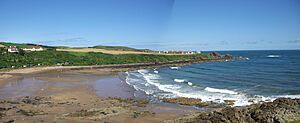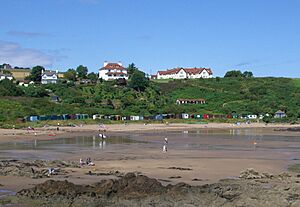Coldingham Bay facts for kids
Coldingham Bay is a lovely inlet on the North Sea coast. It's located in the Scottish Borders area of Scotland. You can find it just over three kilometres north of the town of Eyemouth. A small road from Coldingham makes it easy to reach.
The Beach: Coldingham Sands
Coldingham Sands is the name of the big sandy beach in the Bay. Many people love to visit this beach. On busy days, over 1000 visitors can be there! Coldingham Sands is special because sandy beaches are rare on Berwickshire's rocky coast.
This beach has won many awards. It received the famous Blue Flag award in 2010. It also got the Seaside Award, which is for quieter, more natural beaches. The Marine Conservation Society gave it their top award for cleanliness. This happened in 2006, 2007, 2008, 2009, and 2010. The beach has a cafe, toilets, and parking. It also has access for people with disabilities.
The beach is about 200 metres wide. It is well protected by headlands on both sides. These are Yellow Craig Head to the south and another headland to the north. There are rocky parts at each end of the sand. The beach is very popular with surfers and bodyboarders. A lifeguard is usually on duty during busy summer times.
At the north end of the beach, there are 55 beach huts. Some of these huts are thought to be around 100 years old. People lease these huts from the Scottish Borders Council. The Council owns the sand, but not the huts themselves. Above the huts, on the high ground, are some private homes. There is also the Dunlaverock House hotel.
Exploring the Bay and its Surroundings
Coldingham Bay is part of a special area called the St. Abbs and Eyemouth Voluntary Marine Reserve. This reserve is also part of the Berwickshire and North Northumberland Coast Special Area of Conservation. The rocky shore around the bay is full of marine life. You can find many types of sea creatures and seaweed here. The large tide pools are great for exploring.
Just behind the beach, there are dunes and grassy areas. This is a delicate home for many plants and animals. Visitors are asked to stay on paths to protect this environment. Please do not pick flowers or light fires here.
The Berwickshire Coastal Path goes around the bay. This path offers great walks to nearby St Abbs and Eyemouth. At the south end of the beach is Homeli Knoll. This is a steep hill that gives amazing views of the beach and coast. On the south side of the Knoll, you might spot the small blue butterfly. Its food plant, kidney vetch, grows there. The north side of the Knoll is a good spot for cowslip flowers.
Milldown Burn is a stream that flows into the south part of the Bay. It's the main water source for the Bay. It starts on Coldingham Moor and flows for 6 km through the village of Coldingham. On the north side of the bay, you'll see The Kip. This is an eight-metre-high sea stack. At low tide, it stands on dry land. To the very south of the bay are the 30-metre-high grassy cliffs of Yellow Craig.
For visitors, the St Vedas Hotel offers accommodation. It was built in 1897. There used to be a Youth Hostel in Coldingham Sands. It was also a late 19th-century house. It is now private housing.
Images for kids






